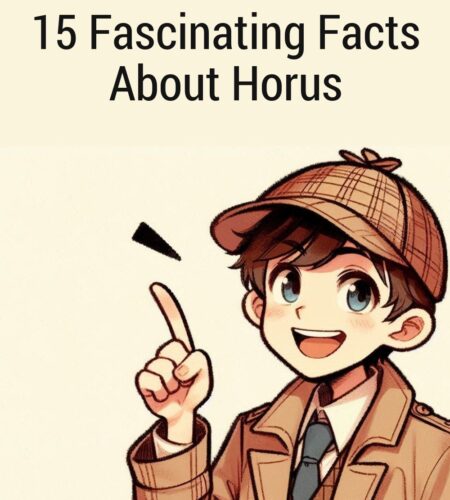Horus, the ancient Egyptian god of kingship and the sky, is a figure deeply woven into the tapestry of Egyptian mythology. With his falcon head and associations with the pharaohs, Horus played a crucial role in the beliefs and rituals of ancient Egypt. Here are 15 intriguing facts about this iconic deity.
Fact 1: The Falcon-Headed God
Symbolic Appearance: Horus is typically depicted as a man with the head of a falcon, representing his association with the sky and celestial realms.
Protector of the Pharaoh: The eye of Horus, also known as the “Wadjet” eye, was a powerful symbol in ancient Egypt, believed to offer protection and healing. Pharaohs often wore amulets in the shape of the Wadjet eye.
Sky God and Sun God: Horus was seen as a celestial deity, associated with the sun and the moon. He was believed to be the god of light and the day sky, while Seth, his rival, was associated with the night sky.
Fact 2: The Divine Avenger
The Osiris Myth: One of the most famous Egyptian myths involves Horus, his father Osiris, and his uncle Seth. Horus battled Seth to avenge his father’s murder and claim his rightful place as king.
Symbol of Order and Justice: Horus became a symbol of justice and order, as his victory over Seth represented the triumph of good over evil and the rightful rule of the pharaoh.
Pharaohs as Horus: Pharaohs were often considered earthly incarnations of Horus, emphasizing their divine right to rule and maintain order in the land of Egypt.
Fact 3: The “Eye of Horus”
The Wadjet Eye: The “Eye of Horus” or the “Wadjet Eye” was a potent symbol representing healing and protection. It was often worn as an amulet or depicted on jewelry and temple walls.
Mathematical Significance: The Eye of Horus was also used as a unit of measurement in ancient Egypt, with each part of the eye symbolizing fractions that could be used for practical purposes.
Healing and Restoration: In addition to its protective qualities, the Eye of Horus was believed to have healing properties and could restore the deceased to life in the afterworld.
Fact 4: Horus as the Uniter of Egypt
The Divine Unifier: In ancient Egyptian history, Horus was often seen as the god who united Upper and Lower Egypt. The pharaohs often associated themselves with this aspect of Horus in their royal titles.
Pharaohs and the Double Crown: The “Pschent,” or double crown, was a symbol of the unified Egypt and represented the joint rule of Upper and Lower Egypt. Pharaohs wore this crown to display their authority over both regions.
Merging of the Lands: The unification of Egypt, with the guidance and blessings of Horus, marked a crucial period in ancient Egyptian history.
Fact 5: Horus as a Child Deity
Horus the Child: Horus was sometimes depicted as a child, often referred to as “Horus the Child” or “Horus the Younger.” He was considered a symbol of youth, innocence, and protection.
Mother Goddess: Horus’ mother, Isis, was a significant figure in Egyptian mythology, and their close relationship added depth to his character. The story of Horus’ childhood is a prominent theme in Egyptian religious texts.
Protection and Nurturing: As a child deity, Horus was believed to offer protection to the vulnerable, just as a mother would protect her child.
Fact 6: The Temple of Horus at Edfu
Magnificent Temple: The Temple of Horus at Edfu, located in present-day Edfu, Egypt, is one of the most well-preserved temples from ancient Egypt. It is dedicated to Horus and was built during the Ptolemaic period.
Architectural Marvel: The temple’s grand architecture and intricate hieroglyphs provide a valuable insight into the religious practices and beliefs of the time.
Festival of Edfu: The annual Festival of Edfu, still celebrated today, commemorates the victory of Horus over Seth and is a testament to the enduring significance of the god.
Fact 7: The Different Forms of Horus
Horus the Elder: In addition to “Horus the Child,” there was also “Horus the Elder” or “Horus the Great.” This form of Horus was often depicted as a mature and regal deity, emphasizing his role as a divine king.
Variety of Roles: The various forms of Horus reflected the multifaceted nature of this deity, who could be a god of the sky, the sun, kingship, and protection.
The Falcon God: The image of a falcon was central to all forms of Horus, emphasizing his connection to the heavens and his ability to soar above the earthly realm.
Fact 8: Horus and the Pharaohs
Pharaohs as Horus on Earth: The association between the pharaohs and Horus was a fundamental element of ancient Egyptian culture. Pharaohs were believed to rule on Earth as Horus ruled in the heavens.
Divine Bloodline: The divine lineage from Horus to the pharaohs was central to the legitimacy of royal authority. This concept was expressed through various rituals and religious ceremonies.
Pharaoh’s Titles: Pharaohs often used titles like “The Living Horus” or “The Two Ladies, the Dual King” to highlight their connection to the god.
Fact 9: Horus and the Solar Myth
Horus and the Sun: Horus was closely associated with the sun, and some versions of the myth depict him as the sun god. This connection reinforced his role as a symbol of light and celestial power.
The Daily Journey of the Sun: The sun’s daily journey across the sky was seen as a reflection of Horus’ own journey, battling darkness and chaos each day.
Horus and the Solar Barque: In Egyptian cosmology, the sun traveled in a divine boat called the “solar barque.” Horus was often portrayed as the pilot of this celestial vessel.
Fact 10: The Role of Horus in the Afterlife
The Afterlife and Ma’at: In ancient Egyptian beliefs, Horus played a role in guiding the deceased through the afterlife, helping them navigate the judgment of the goddess Ma’at.
Protection in Death: The Eye of Horus symbol was often inscribed on funerary texts and tombs to ensure the deceased’s safe journey to the afterlife.
The Judgment of the Heart: Horus was sometimes invoked to assist in the deceased’s judgment. He would help ensure that the heart of the deceased was lighter than a feather, indicating a virtuous life.
Fact 11: Horus and the Kingship Rituals
Coronation and the White Crown: The pharaoh’s coronation included the ritual of wearing the “Hedjet,” the White Crown of Upper Egypt, symbolizing Horus’ dominion over this region.
Integration of Upper and Lower Egypt: The unification of Upper and Lower Egypt was represented by the pharaoh’s donning of both the White Crown of Upper Egypt (Horus) and the Red Crown of Lower Egypt (Seth).
Reenactment of Myths: The kingship rituals performed by the pharaohs often involved the reenactment of significant myths related to Horus, including his battles with Seth.
Fact 12: Horus in Greco-Roman Culture
Cultural Influence: The worship of Horus extended beyond Egypt’s borders, particularly during the Hellenistic and Roman periods. He was identified with Greek and Roman deities, such as Apollo and Jupiter.
Isis and Osiris Cult: The spread of the Isis and Osiris cult throughout the Roman Empire brought increased recognition of Horus as part of this divine family.
Surviving into Modern Times: Horus’ influence can still be found in modern esoteric and New Age belief systems, where he is often associated with spiritual protection and guidance.
Fact 13: The Winged Sun Disk
The Winged Sun Disk: In some depictions, the sun disk was portrayed with wings and a uraeus (cobra), symbolizing Horus’ connection to the sun and his protective qualities.
Decorative Element: The winged sun disk was a common decorative element in ancient Egyptian art and architecture, adorning temples, tombs, and other structures.
Continued Symbolism: Today, the winged sun disk is recognized as a symbol of ancient Egyptian culture and has been used in various contexts to represent Egypt’s rich heritage.
Fact 14: Horus and the Perseus Myth
Parallels in Mythology: Horus shares some similarities with the Greek mythological hero Perseus. Both were born of divine parentage and played crucial roles in defeating monstrous adversaries.
Confrontation with Seth and Medusa: In one version of the myth, Horus’ battle with Seth is likened to Perseus’ confrontation with the Gorgon, Medusa, where her decapitated head is used as a weapon.
Cultural Exchanges: These similarities may reflect cross-cultural exchanges between the ancient Egyptians and other Mediterranean civilizations.
Fact 15: The Eternal Spirit of Horus
Enduring Legacy: Horus’ legacy endures in various forms, from his historical significance in ancient Egypt to his continued presence in popular culture and modern spiritual practices.
Symbol of Protection: The Eye of Horus remains a potent symbol of protection and healing. It is a frequent motif in jewelry, tattoos, and amulets.
Eternal Vigilance: In the eyes of the ancient Egyptians, Horus was not just a god of the past but a celestial being who continued to watch over the world and guide souls on their journey.
Conclusion
Horus, with his falcon head and multifaceted role in ancient Egyptian mythology, continues to captivate the imagination. From the protection offered by the Eye of Horus to his connection with the sun and the enduring legacy of Egyptian culture, Horus represents an essential facet of ancient Egypt’s rich history and belief system. His influence, both as a deity and a symbol, remains a testament to the enduring power of mythology in shaping cultures and civilizations.
Subscribe to our email newsletter to get the latest posts delivered right to your email.




Comments